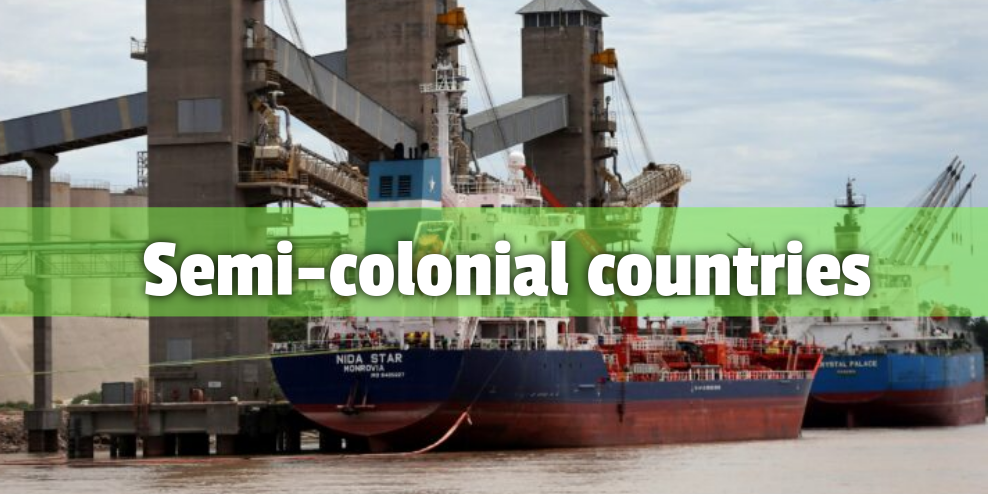Semicolonial countries

Formally and legally independent states whose national capitals are nevertheless revalorized thanks to one or two primary export industries. The state acts as a redistributor of profits within national capital, ensuring demand from the rest of the productive sectors, which necessarily assume a subordinate role.
The general picture of the semicolonial world is that of an export sector that subsidizes the rest of investments via the state, a permanent tendency to devaluation and monetary storms due to capital flight and currency hoarding that inevitably occur due to the lack of internal investment destinations. And as a consequence, difficulty in maintaining and attracting foreign capital as well as periodic crises in the public accounts.
Bases and consequences of the semicolonial economy
Historically, these are national capitals which arrived relatively late in the global capitalist competition. In them, when capitalism was already entering its imperialist phase, a national industry was just beginning to emerge. When it finally emerged, the internal non-capitalist markets -the artisans, the independent peasantry, etc.- did not have the capacity to generate sufficient demand for all the value produced by the export sector.
That is, they are national capitals that were already born with a pressing need to conquer foreign markets. In the countries of older capitalisms, this hunger for markets - and for the destinies for capital that accumulated in each cycle - was translated into militarism and a violent struggle for colonies, into a brutal increase in the centralization and concentration of capital that would end up in the monopolies and the state capitalism of today, and into two world wars.
But these national capitals then came from colonial economies. Apparently, there was no shortage of buyers. The same imperialist powers which were at each other's throats, driving millions of workers to die in the fields of honor in order to secure them profits, supplied themselves with raw materials of all kinds by buying from semicolonial countries in massive quantities. Logically, national capital concentrated even more on these export industries.
The paradox was that those who apparently had no problems in exporting, could not easily reach the massive industrialization that had characterized rising capitalism. The reason is understandable. The primary sector cannot increase its productivity at the same rate as the industrial and service sectors. It will soon find a limit to the placement of capital. In the industrial and service sectors it is way easier to invest in new productivity-raising technology or organization than in the primary sectors, in other words, the extraction of relative surplus value is harder in the primary sector. Moreover, international demand will peak sooner or later or even fall. And what is even worse: international prices will vary according to the situation and as the capital of the buyers is concentrated in large foreign monopolies, these will exercise more and more power over the margins. As a result, the accumulated profits of the primary sector, at a certain point, will have difficulty in being placed in the sector itself. And outside of it... there is little or nothing. The situation of these countries had gone from being colonial to... semi-colonial.
How will the national capital try to get out of the quagmire? By developing a particular form of state capitalism that we find today from Argentina and Chile to Cuba and México, but also in a large part of Africa and Asia:
The state will charge the primary sector with double-digit export taxes and thus maintain a consumption base and a tariff-protected and, in many cases, directly subsidized industry. In other words, the state guarantees the realization of the surplus value that the market by itself could not realize, on the export taxes of a couple of products on the international market.
In periods of commercial peace and increasing prices of what they export - such as wars between great powers - the aim of governments will be to strengthen the national capital by closing imports and trying to create a base of internal consumption capable of serving as a demand for domestic industry. This is the whole secret of the South American cyclic miracles: the rate of profit increases in these periods, capital reproduces itself happily and the state is able to sell its policies of strengthening demand as productive revolutions. These are temporary joys. The Venezuelan case is paradigmatic. The Bolivian case is even more so. The Argentinean case, even starting from a much more developed national capital, has followed the script. South Africa and Turkey, too.
But there is more: the lack of a domestic market in which to sell new products produces an endemic lack of opportunities for national capital to place itself. That is the reason why the deficit in the balance of payments -inward and outward capital- is endemic. The national capital of semi-colonial countries is always bleeding away. And it does not do so because of the supposedly stateless nature of national capital or because of the betrayal of a creole bourgeoisie sold to imperialism. It does so precisely because semicolonial capitalism is imperialist. In the absence of markets in which to export industrial goods and services, it exports capital. And these exports, which in moments of global crisis become massive flights, are responsible for a permanent tendency towards inflation and currency crisis.
The fact that in many cases the peculiar geographic and economic conditions do not allow expansionism, does not deny the daily game of pressures and alliances, nor the entire economic reality. Imperialism, under semicolonial conditions, is exactly what we see in semicolonial countries. Turkey and South Africa, so similar to other semicolonial peaceful countries but in different neighborhoods, show that the militarist and expansionist temptations beat under the general conditions of imperialism and manifest themselves... when there is opportunity.
http://dictionary.marxismo.school/Semicolonial countries